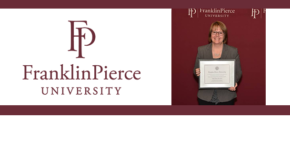 The health care field is continually changing course.
The health care field is continually changing course.
Willow Henry, professor of health care practice at Franklin Pierce University, examines one instance of finding a new way of doing things.
Willow Henry, P.T., D.P.T., as the Dr. Arthur M. Pappas Professor of Health Care Practice Endowed Chair at Franklin Pierce University in New Hampshire.
Dr. Henry is a wound-care expert and an assistant professor in the College of Health & Natural Sciences, teaching within the Doctor of Physical Therapy program at the University’s Manchester, N.H., Academic Center: https://www.franklinpierce.edu/academics/programs/physical-therapy/index.html.
After previously serving as an adjunct professor, Dr. Henry has been a full-time assistant professor at Franklin Pierce University since May 2017. She is an American Board of Wound Management Certified Wound Specialist and her proposal application focused on the interprofessional management of wounds. She theorizes that wound-care management by a team of experts improves outcomes, decreases wound chronicity, and decreases healthcare costs. Dr. Henry’s research and expertise in wound care and infectious diseases was key as she led the university’s Manchester, N.H., Academic Center’s reopening task force to ensure in-person instruction at the height of the COVID-19 pandemic.
A native of Vermont, Dr. Henry earned her bachelor of science in physical therapy from the University of Vermont and her doctor of physical therapy from Des Moines University.
Physical Therapy and Wound Healing
As the field of physical therapy and PT education continue to evolve, there is growing interest in collaborative-care models specifically in the field of wound management. My own research focuses on how wound care is most effectively addressed by a multidisciplinary team, with physical therapists playing a key role throughout the process of patient healing.
It is easy for many in healthcare to have tunnel vision and to just focus on the wound itself, when nearly 100 percent of the time you have to look at the patient as a whole to figure out what is preventing them from moving through the normal stages of healing. This is particularly true as a chronic wound develops.
In today’s collaborative-care models, it takes a village to help a patient who is not healing and to move them towards recovery. Within that village are many different members of the medical community: Physicians, nurses, occupational therapists, physical therapists and others.
In many cases, even with the treatment of a team, the reason that patients are not healing is because they are not moving. And physical therapy is movement. “Movement as medicine” is a huge piece of how patients who have stalled wounds start healing again because we get them up, mobilized, and moving.
Indeed, movement is a key component in wound care, and wound care is an important and growing niche within the field of physical therapy.

Comments
6 responses to “Willow Henry, Franklin Pierce University – Physical Therapy and Wound Healing”